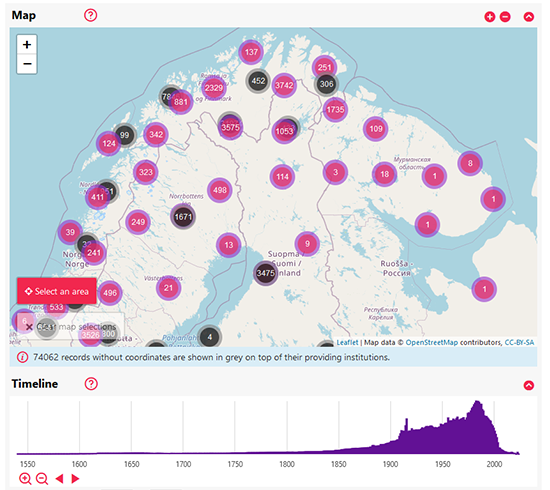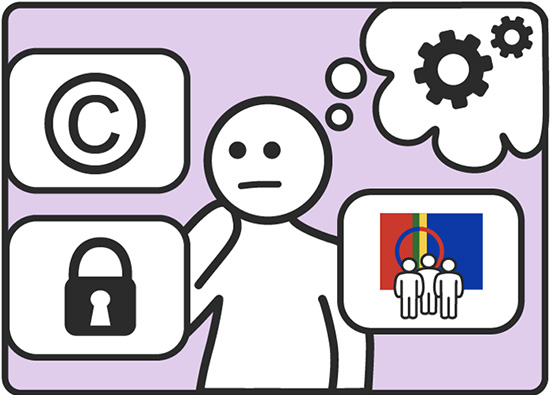Above all, Nuohtti offers Sámi people an opportunity to delve deeper into historical material concerning their own culture. Photo: Matilda Kalving.
The Nuohtti digital service provides access to a wide range of archive material on Sámi cultural heritage. Nuohtti contains 30,000 documents and photos from the Sámi area gathered from 32 European archives, libraries, and museums. The service responds especially to the need and right of the Sámi to get information about themselves and their people. Launched in February, the service has been developed by a multidisciplinary Nordic project led by the Faculty of Art and Design at the University of Lapland.
For roughly 400 years, archive material on Sámi cultural heritage has
been created by officials, scientists, explorers, and missionaries from
all over Europe when visiting or working in the Sámi area. Up until now,
this material has been scattered in archives around Europe. A large
amount of this archive material is now digitally available through the
Nuohtti service. In collaboration with the universities of Oulu and Umeå
and the Sámi Archives of Finland and Norway, the service has been
developed by a multidisciplinary Nordic project led by the Faculty of
Art and Design at the University of Lapland.
"We started
developing the service at the request of the two Sámi Archives in order
to provide easier access to material residing in different parts of
Europe. In particular, we intended to create a service that enables
Sámi people to get information about their cultural heritage and brings
it back to them in a digital format," says Jonna Häkkilä, professor of
industrial design and the leader of the project from the Faculty of Art
and Design at the University of Lapland.
Following an extensive
feat of mapping and development, Nuohtti now provides access to roughly
30,000 digitised documents and photos from the Sámi area collected from
32 European archives, libraries, and museums. Among other things, you
can use Nuohtti to search photos taken by private persons and officials,
ethnographic reports, Sámi missionaries' diaries, Lapp taxmen's
diaries, and court documents. The service is available in five
languages: Northern Sámi, English, Finnish, Swedish, and Norwegian.
Indeed, the archives can now be searched using Northern Sámi as well.
"In
terms of technology, the database can also be expanded and more archive
material can be imported, for instance, as soon as it gets digitised by
the European memory institutions. The technology also enables the
inclusion of other Sámi language versions, provided that funding can be
arranged," Häkkilä notes.

You can search material by selecting areas on the map or a desired
time period on a timeline. Photo from the Nuohtti service.
The outcome of multidisciplinary collaboration
According
to Professor Jonna Häkkilä, the University of Lapland as a northern and
Arctic actor has a special responsibility to support the fostering and
preservation of our northern indigenous people's cultural heritage.
Developing a multidisciplinary and international service such as Nuohtti
requires large investment, for which a single archive does not have
sufficient resources.
"In situations like this, a university can
gather various actors to a joint venture, whereby the basis is broader
and the chances to get funding are better. A multidisciplinary project,
in this case Nuohtti, also requires extensive expertise in areas such as
technology, user-centred design, usability, archives, Sámi culture,
cultural history, and ethical issues. I am glad that the University of
Lapland had enough experience and expertise to complete a venture of
this magnitude and that the collaboration between the participants went
so well," Häkkilä says.
In constructing the Nuohtti service, the
expertise of the partaking organisations united into a multidisciplinary
whole that was driven forward by twenty or so persons at three
universities and two Sámi archives.
First, the Sámi Archives
mapped the European memory institutions that possess material related to
Sámi cultural heritage and whether the material has been digitised.
Meanwhile, the universities of Lapland and Umeå deliberated over the
concept of the new service, its customer requirements, and its user
interface. The University of Oulu, for its part, had a tech team that
was in charge of developing the interfaces between the archives and
Nuohtti and programming the user interface.
Furthermore, the
University of Lapland organised the creation of ethical guidelines and
the collection of user feedback by arranging prototype testing sessions
at five libraries in Finnish Lapland and at the schools of Kilpisjärvi
and Vuotso. The Finnish, Swedish, and Norwegian Sámi Parliaments
appointed their representatives to the steering group, in which they
were actively involved throughout the project.
"We worked hard to
make Nuohtti flawless and user-friendly. We wanted to create a
so-called one-gate user interface through which you can search material
from different archives with a single keyword. In addition, you can
search material by selecting areas on the map or a desired time period
on a timeline," Professor Häkkilä notes.

Nuohtti has jointly-established ethical guidelines. They are shown
for example as cartoons. Photo from the Nuohtti service.
Ethical guidelines as part of the service
The
material in the European archives has largely been created and
collected by persons outside the Sámi community. Nuohtti has
jointly-established ethical guidelines that users are expected to
follow. The creation of the guidelines was led by Iiris Kestilä, a
doctoral researcher in the Faculty of Law at the University of Lapland.
"We
also aimed to make the ethical guidelines user-friendly. They are
integrated into the service and can be found on the front page.
Guidelines of this type are often rather long, and people may avoid
reading them. We therefore chose to make cartoon-type guidelines. In
addition, Nuohtti has a quiz for testing your knowledge of how to use
material that belongs to indigenous peoples' cultural heritage," Häkkilä
says.
Häkkilä thinks that the ethical guidelines may also apply elsewhere and that they can be utilised in corresponding cases.
The
national archives of Norway, Sweden, and Finland and the Sámi archives
of Norway and Finland are in charge of the Nuohtti digital service. It
is open to everyone interested in Sámi history and culture. Above all,
the service offers Sámi people an opportunity to delve deeper into
historical material concerning their own culture.
Nuohtti has
been developed as part of the Nordic Digital Access to the Sámi Heritage
Archives project in 2018–2021. The project was led by the University of
Lapland and it was carried out in collaboration with the Sámi Archives
(Inari) of the National Archives of Finland, the Sámi Archives of Norway
(Kautokeino), the University of Oulu, and Umeå University. The project
was funded by the Interreg Nord Programme of the European Union.
Further information:
Professor Jonna Häkkilä, phone +358 40 484 4203, firstname.lastname (at) ulapland.fi
Nuohtti service: www.nuohtti.com